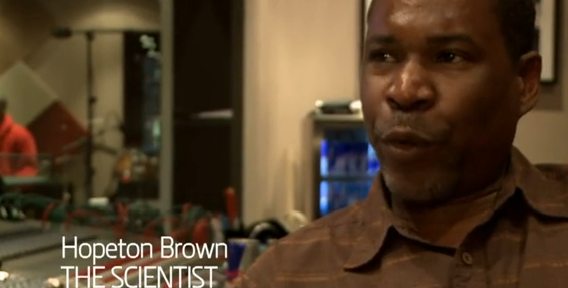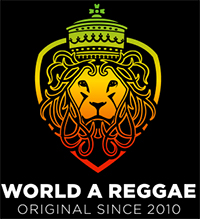Scientist is a man considered by many to be the greatest living mixologist. As a recording engineer and producer, he has singlehandedly defined the art of mixing and dub. We are talking about the man who gave us the greatest dub reggae albums since Augustus Pablo’s King Tubby Meets Rockers Uptown, widely considered to be the greatest dub album of all time. Many “Best of” lists even crown the album as the greatest reggae album ever recorded. If you haven’t experienced Scientist’s Heavyweight Dub Champion, Scientist Rids the Earth Of The Evil Curse Of The Vampires, and The Greatest Dub Album In The World, you are more than likely ill-advised to comment on what makes for good music.
Scientist, never one to shy away from controversial statements, has made his assessment of the quality of today’s reggae records and it is not a positive one.
“All these records are watered down,” he explained during our recent interview. “How can you record a record in an office building or strip mall made of drywall and expect it to sound like a record recorded at Channel One Studio – built of concrete and steel? I can show the technical differences. It cannot be done. There is a technical advantage to recording in a concrete and stone structure versus what you see now. You don’t have to take my word for it. Listen for yourself. The proof is in the discography.”
Scientist, born Hopeton Brown in Kingston, Jamaica (1960) , began toying with amplifiers as a youth. Brown was introduced to electronics by his father, who worked as a television and radio repair technician. His many hours spent hanging at King Tubby’s Dromilly Road studio paid off when Tubby took him on as an assistant and initially allowed him to create dubs of reworked Studio One riddims for Don Mais’ Roots Tradition label. The very first hit record that he mixed was for a young man with a unique vocal delivery from Clarendon named Barrington Levy. The record was “Collie Weed”, which was pressed in 1979.
Brown was hired on in the late 1970s by the Hoo Kim Brothers at Channel One Studio, which allowed him to work on a 16-track mixing console rather than the four tracks at Tubby’s. It was at Channel One that he cut his teeth mixing for the greatest artists Jamaica had to offer. He talked about his experience at Channel One in an interview by Nice Up!
“My first major session at Channel One was intense. Working at Channel One is like working at a live concert. I was on my own with only the experience from Studio One days doing overdubs. I applied some of the technique to the sessions at Channel One Studio. Working with Oswald, Earl ‘Chinna’ Smith and the High Times Players they are so good to work with they are low profile no egos people.”
He came to prominence in the early 1980s as a gifted mixologist and dub master who many, if not most, of the popular releases in the first part of the decade. He was a favorite of producer Henry “Junjo” Lawes, which led him to record many memorable albums featuring the Roots Radics. His discography during this period is much too long to list, however, it is documented at www.roots-archives.com. It is during this period that he produces Linval Thompson’s and Jah Thomas’ most memorable work.
He is perhaps best known for the Scientist dub albums that he started releasing in the early 1980s. These albums, which were released on the Greensleeves label, had outlandish and sometimes comical names like Scientist Meets the Space Invaders, Scientist Rids the World of the Evil Curse of the Vampires, Scientist Encounters Pac-Man, and Scientist Wins The World Cup. It is on these dub albums that Scientist shines brightest, pushing the limits of contemporary studios, instruments, and mixing consoles.
After doing a short stint at Tuff Gong Studio working under legendary engineer Errol Brown, Scientist moved to Washington, D.C. in 1985 to continue his mastery of the mix by lending his talent to the D.C.-based RAS Records. It is this move to the U.S. where he first notices a change in the sound of reggae recordings. Leaving the confines of an authentic Jamaican recording studio, he is able to make a clear distinction between what he hears coming from these new studios versus what he hears coming out of the Jamaican studios.
“Make no mistake, I have the factual things to back it up. I’m not just talking from reference. I remember when I first get into reggae the sound, and style coming out of Studio One. I have to fight all the musicians to change it to get that big fat sound. So when I hear the watered down reggae today, I know the difference. I have the records as proof to show you.”
“When you evaluate much of what you hear today, it is a highly subjective thing. If you are comparing it to other contemporary reggae, then most of it is watered down. If you compare it to King Tubby or those recordings at Channel One, you have to be really biased to say it sounds as good or better.”
Scientist is clearly on to something in this analysis. Lost is that heavy, distinct, almost electrifying sound – that sound that you can not only hear, but feel – in many of today’s recordings. You cannot reproduce the sound of Bob Andy’s “Unchained”, which was recorded at Coxsone’s Studio One. You cannot reproduce the sound of Lee “Scratch” Perry’s Blackboard Jungle, which was recorded at the Black Ark. You cannot reproduce the sound of those early Revolutionaries albums, or Mikey Dread’s African Anthem, or Yabby You’s albums, or Jammy’s Kamikazi Dub, all of which were recorded at Channel One. But that same sound that we can no longer reproduce is what makes these albums such “classics.” How historic would Augustus Pablo’s East Of The River Nile be if you could spit one out in every studio in the U.S. right now?
Scientist’s opinion is in no way meant to be controversial, or to denigrate today’s producers and engineers, it is simply a statement of fact that is, as Scientist explained, supported by the discography.
“Here’s what man, say you go to a good Chinese restaurant here in the U.S. and they feed you the garbage and you like Chinese food. You have been under the impression that you’ve been eating good Chinese food for long time. Now you go to China and eat the real thing. There is no way to compare the two. One is Chinese food and one is watered down Chinese food. It is the same with this reggae.”
Watered down reggae notwithstanding, Scientist continues to push the envelope in the studio, even venturing into the realm of dubstep, soul, and rock. He is currently working on dubs and remixes for Slightly Stoopid’s new album Top Of The World out of his California studio. He is also very active with his website, which he launched more than 15 years ago, www.dubmusic.com. He launched dubmusic.com as an online community for dub and reggae artists and enthusiasts to share their music. He calls it the “myspace of dub and reggae.” His dub version of Bob Marley and the Wailer’s Lively Up Yourself” can be heard on the recently released Bob Marley and the Wailers In Dub Volume 1.
Check his remix of Marvin Gaye’s “What’s Going On” or “Beyonce/Lady Gaga Meet The Scientist Remix”, or “Interpol Scientist Dub Mix” at his website www.dubmusic.com and you will be left with no doubt that this man has the chops to speak on what he knows.
www.dubmusic.com
Scientist at Roots Archives


